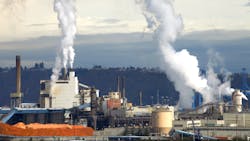Heavy industry has earned a reputation for its impact on the environment due to the production of greenhouse gases, inefficient water and energy usage, and generation of significant waste. Process manufacturing companies are thus being forced from a business and image perspective to address sustainability and be world leaders in the fight against climate change, as it is no longer possible for companies to operate without considering their impact on the environment.
To address the global concern of sustainability, in 2015 the United Nations (UN) adopted seventeen sustainable development goals (SDGs) as “a universal call to action to end poverty, protect the planet and ensure that all people enjoy peace and prosperity by 2030.” Of the seventeen goals1, these are the four which process manufacturers should address to have the most significant impact:
- Goal 6: Clean Water and Sanitation: Ensure availability and sustainable management of water and sanitation for all.
- Goal 7: Affordable and Clean Energy: Ensure access to affordable, reliable, sustainable and modern energy for all.
- Goal 12: Responsible Consumption and Production: Ensure sustainable consumption and production patterns.
- Goal 13: Climate Action: Take urgent action to combat climate change and its impact.
Many process manufacturing companies are using the UN SDGs, particularly the four listed above, as a basis for their corporate sustainability initiatives. Process manufacturing companies typically have personnel, with titles like sustainability officer, whose sole job is to focus on their company’s environmental performance. It is clear the industry is taking the issue seriously and making significant investments in sustainability.
In addition to meeting business and social obligations, there’s another reason that companies are investing in sustainability: it is good for business. Sustainable manufacturing involves efficient use of raw materials, less waste and lower energy consumption — all of which provide significant cost savings. In addition to lowering operating costs, sustainable practices boost a company’s reputation, giving it a competitive advantage in the market.
Problems with current approach
While process manufacturing companies are clearly investing in sustainability, there are challenges. Sustainability goals and initiatives are typically developed at a corporate level, often without any specific, actionable requirements for plant personnel. Plant operators, technicians and subject matter experts (SMEs) may not have the insights they need into their process data to implement improvements, with many still relying on spreadsheet applications to perform analyses.
Spreadsheets do not have the tools required for advanced analytics, so contextualizing data, signal cleansing or building regression models is difficult and time-consuming (Figure 1). As a result, developing measurable sustainability key performance indicators (KPIs) to improve outcomes is nearly impossible.
Due to the lack of insight into their process data, most sites only focus on environmental and social governance reporting and compliance as metrics for their success. Operators thus focus on monitoring a single indication of environmental performance (i.e. emissions levels), and SMEs spend many days a month wrangling historical data to simply document compliance. If an environmental violation does occur, corrective actions are only taken after the event, and there is a lack of insight to determine what actually caused the problem. In short, without the right analytics tools, organizations are, at best, reactive to a site’s environmental impact, and at worst oblivious.
Fortunately, there are software solutions to address these and other issues.
Advanced analytics addresses issues
With the right advanced analytics solution, process manufacturing organizations gain more insight into their environmental process data. At a minimum, this enables faster, easier compliance reporting. Reports can be automatically updated based on the latest data, so SMEs no longer have to spend valuable time wrangling data to generate reports, and can instead work on process improvement projects, like optimizing environmental performance.
In addition to automating current workflows, advanced analytics solutions enable users to improve from a compliance-focused and reactive sustainability approach. Advanced analytics enables SMEs to identify correlations between environmental performance and process parameters, for example. These parameters can then be continuously monitored for proactive mitigation of environmental violations. And if a violation does occur, engineers are quickly able to assess process performance and identify leading events to the incident.
Advanced analytics can do even more than monitoring and incident investigation, as SMEs can build environmental models to better understand how process changes will impact environmental performance. These models can predict process or equipment behavior based on operating conditions (Figure 2), and they can provide many other benefits.
The real-time collaboration capabilities provided with advanced analytics software accelerate insights, which can then be communicated with the broader organization. This alleviates the siloed and error-prone analyses that exist when organizations are dependent on spreadsheet applications for data analysis, providing progress towards reaching SDG goals.
Affordable and clean energy
While this goal cites the need for all people to have access to electricity, it also recognizes that the world economy is too reliant on fossil fuels. With the energy sector as the main contributor to climate change, producing more than 60% of the world’s greenhouse gases2, investment in alternative energy sources — like wind, solar and thermal power — must be part of the solution. This goal also addresses the need to increase energy efficiency across all verticals
Allnex, a specialty chemical company, is using advanced analytics to construct energy models to decrease a site’s total energy consumption, with minimal required capital expense. It is further leveraging advanced analytics to monitor parameter drift, so issues are discovered early and proactively.
Responsible consumption and production
To support a growing population, it is necessary to produce required goods based on a more sustainable model. This requires more efficient use of raw materials, recycling, less waste and responsible handling of the waste that is created.
Advanced analytics software supports these efforts in a variety of ways across industry verticals. Sites can use this software to monitor a plant, process or equipment’s mass balance. While performing a mass balance equation is not a new concept, plants typically use methods that are difficult to maintain and do not update as new data becomes available. However, with the right tools, mass balance calculations can be run continuously to track changes over time. The results of these calculations can be used for many purposes — for example to identify leaks indicating a waste of material.
In another example, food and beverage companies are using advanced analytics to optimize their clean-in-place (CIP) process. Traditionally, CIP cycle times are based on historical sampling, not real-time data and analytics. This approach tends to be conservative and err on the side of over-cleaning rather than under-cleaning, wasting both energy and resources. Analyzing and monitoring CIP data in near real time allowed one site to identify when the process was sufficiently clean, so cleaning solution would not be wasted. In addition to the resource savings, preventing over-cleaning decreased process downtime and increased production.
Climate action
Reimaging energy production and transmission is critical to accelerating climate action progression at a global level. Both developed and emerging countries need clean sources of energy to power their futures sustainably. Energy producers, as an example, are partnering more closely with governments, regulators, academic institutions, financial partners and others in alliances like the Oil and Gas Climate Initiative to tackle these challenges at a macro level.
One area of promise is collaboration between private and public partners across the energy, the and power and utilities, industries. These coalitions leverage advanced analytics to increase renewables generation, accelerate smart grid adoption and proactively mitigate carbon emissions.
One example is in methane emissions. Several United States independent energy producers are working with private and public partners to aggregate methane emissions information from satellite, weather and wind data — and from devices collecting data regarding volatile organic compounds and processes.
This varied combination of data types can be accessed using advanced analytics software to more accurately identify and predict sources of methane leaks (Figure 3).
With this data available across hundreds to thousands of oil production sites, not only are super methane emitters detected down to the source system, but emissions can be detected at a micro level (such as slow, small leaks) using machine learning models. According to the EPA, methane is 25 times worse as a greenhouse gas than CO2. Every step that can be taken to prevent a methane leak, or unnecessary methane flaring or venting, therefore yields considerable improvements.
Conclusion
As a major contributor to global emissions and climate change, it is critical for process manufacturers to take a leading role in supporting the UN sustainable development goals. With the right advanced analytics solutions, it is easy to get started by applying the following best practices:
- Choose a meaningful use case with a clear, measurable outcome.
- Start with an analysis where the required data is available.
- Focus the initial investigations on a single process or asset.
- Once optimization opportunities are identified, apply process modifications to drive improved environmental performance.
- Monitor performance to quantify the process and environmental improvements.
- Once the positive outcome is clear for a single process or asset, scale the solution to other similar assets or processes.
It is important to take a “nail it, then scale it” approach by starting small to prove value, and then scaling the analysis to other parts of the process. This approach provides meaningful outcomes to drive environmental performance and create enthusiasm within the organization. While the overall objective is to move away from a compliance-based sustainability model to one driving environmental optimization, it’s important to document all positive impacts on operations.
References
- UN Sustainable Development Goals: https://www.undp.org/content/undp/en/home/sustainable-development-goals.html
- Oil and Gas Climate Initiative: https://oilandgasclimateinitiative.com/
- Microsoft Sustainability Calculator helps enterprises analyze the carbon emissions of their IT infrastructure: https://azure.microsoft.com/en-us/blog/microsoft-sustainability-calculator-helps-enterprises-analyze-the-carbon-emissions-of-their-it-infrastructure/
- Amazon: https://sustainability.aboutamazon.com/environment/the-cloud#section-nav-id-1
Megan Buntain is the director of cloud partnerships at Seeq Corporation, a company building advanced analytics applications for engineers and analysts that accelerate insights into industrial process data. She was formerly a consultant with analytics, IoT and blockchain software and services companies, and prior to that worked at Microsoft for 15 years.
Lindsey Wilcox is an analytics engineer at Seeq Corporation, where she helps engineers get the most value out of their process data by using advanced analytics software. She started her career at Westinghouse Electric Company, working to ensure the safe operation of U.S. nuclear power plants. After that, Lindsey led the Field Services team at Control Station, a software company focused on process control optimization. In this role, Lindsey analyzed PID controller data in a wide range of industrial environments. Lindsey has a passion for process data analytics and empowering customers to improve plant efficiency through the use of cutting-edge technologies, and she holds a B.S. in Chemical Engineering from the University of Connecticut.





